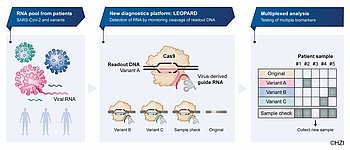CRISPRdetect – multiplexed RNA detection with reprogrammed tracrRNAs
Keywords
CRISPR-Cas, RNA detection, diagnostics, multiplexing, point-of-care (POC)
Invention Novelty
Provided is a scalable RNA detection platform technology that can expand numerous applications of multiplexed diagnostics for clinical testing facilities and point-of-care (POC) testing.
Value Proposition
Our ability to improve patient health and treat disease is built around the information we can collect about a person’s health status. Diagnostic tests play a key role in collecting this information. However, these tests often can only collect a few pieces of information, limiting insights into health and how decisions are made around patient care.
Technology Description
Provided is a new, first-in-class technology platform called LEOPARD that can collect large amounts of information with a single test. The technology is built around a new discovery in CRISPR biology that was converted into a means to detect large number of RNA transcripts in parallel. TracrRNAs are engineered to hybridize with a biomarker RNA, converting that RNA into a guide RNA that directs sequence-specific DNA cutting by a tracrRNA-dependent Cas9 nuclease. LEOPARD has the potential to offer fast and multiplexed readouts with simple machinery that provides immediate advantages over multiplexed PCR, next-generation sequencing, and mass spectrometry. The technology can also be applied for point-of-care testing that could offer the first rapid and multiplexed testing devices that could be used outside of clinical settings.
Commercial Opportunity
The technology is offered for co-development and/or licensing
Development Status
Current efforts focus on the development of a multiplexed detection systems based on microarrays and lateral flow strips
Patent Situation
A European priority application was filed in February, 2020, an international PCT-application is pending (WO 2021170877).
Further Reading
Jiao et al. 2021. Science 372, 941–948




